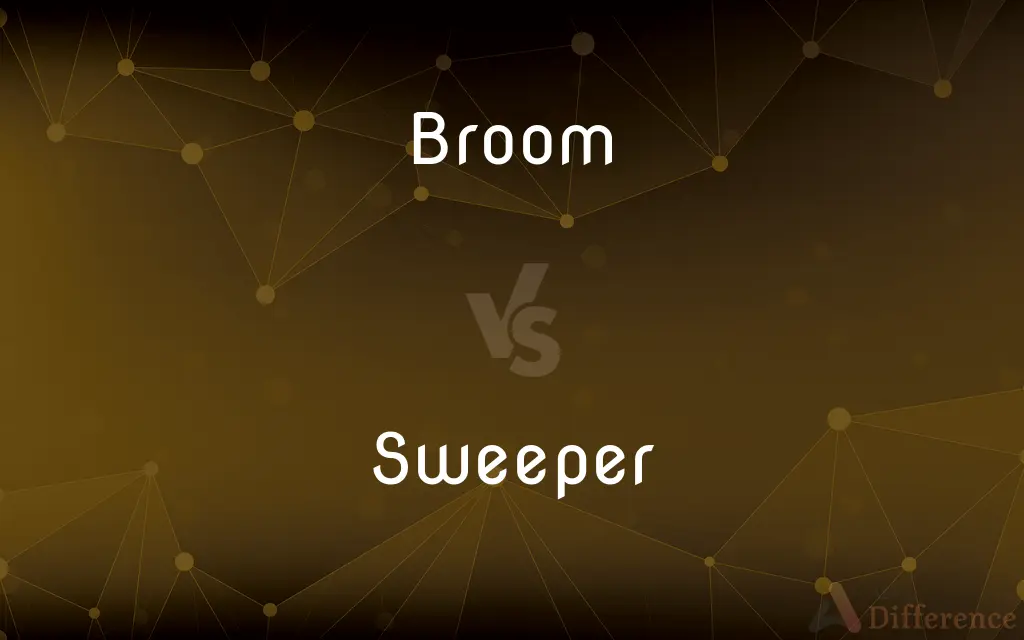Broom vs. Sweeper — What's the Difference?
By Fiza Rafique & Urooj Arif — Updated on April 23, 2024
A broom is a traditional cleaning tool with bristles attached to a handle, used for sweeping, while a sweeper can refer to various types of mechanical or manual devices designed for cleaning floors.

Difference Between Broom and Sweeper
Table of Contents
ADVERTISEMENT
Key Differences
A broom typically consists of a long handle with stiff fibers (bristles) at one end, designed for sweeping dirt and debris manually from floors and other surfaces. In contrast, a sweeper might be a more complex device, either manual or powered, such as a carpet sweeper or a street sweeper, designed to clean larger or more specific areas.
Brooms are primarily used in residential settings for basic floor cleaning and can be made from natural materials like straw or synthetic fibers. On the other hand, sweepers, especially mechanical ones, are often used in commercial or industrial contexts to handle larger spaces or heavier debris.
The manual operation of a broom requires physical effort and is generally used for dry conditions to gather loose particles. Whereas, sweepers can be equipped to handle both dry and wet conditions, often being more versatile but also more expensive.
Brooms can be very effective for getting into corners and small spaces due to their simple design and maneuverability. Meanwhile, sweepers, particularly the larger mechanical models, might struggle with tight spaces despite being more efficient in open areas.
The maintenance of a broom is relatively straightforward, usually requiring just a rinse or a shake to remove collected debris. Sweepers, particularly those that are mechanical, require more complex care, including emptying waste containers, charging batteries, or maintaining mechanical parts.
ADVERTISEMENT
Comparison Chart
Type
Manual cleaning tool.
Manual or mechanical cleaning device.
Common Usage
Residential, simple cleaning tasks.
Commercial, industrial, various scales.
Operation
Manually pushed.
Manually pushed or powered.
Material
Natural or synthetic bristles.
Varies widely, including brushes and rollers.
Maintenance
Low maintenance, easy to clean.
Higher maintenance, mechanical care.
Compare with Definitions
Broom
Suitable for indoor and small areas.
She used a small broom to clean the corners of the room.
Sweeper
Can refer to a manual or powered cleaning device.
The janitor used an electric sweeper for the school corridors.
Broom
Cleaning tool with bristles fixed on a handle.
She swept the kitchen floor with a traditional broom.
Sweeper
More complex than a broom, involves mechanical parts.
The mechanical sweeper needed repairs after a month of heavy use.
Broom
Used manually for sweeping.
He grabbed the broom to clear the leaves off the porch.
Sweeper
Requires more storage space.
They stored the bulky sweeper in the maintenance shed.
Broom
Requires physical effort to operate.
Cleaning the large hall with a broom took a lot of effort.
Sweeper
Often used for larger areas.
A street sweeper cleaned the downtown area every night.
Broom
Simple design, easy storage.
The broom fit neatly into the cleaning closet.
Sweeper
May include features for both dry and wet cleaning.
Their new sweeper could vacuum dirt and mop at the same time.
Broom
A broom (also known in some forms as a broomstick) is a cleaning tool consisting of usually stiff fibers (often made of materials such as plastic, hair, or corn husks) attached to, and roughly parallel to, a cylindrical handle, the broomstick. It is thus a variety of brush with a long handle.
Sweeper
Sweepers are small, tropical marine (occasionally brackish) perciform fish of the family Pempheridae. Found in the western Atlantic Ocean and Indo-Pacific region, the family contains about 26 species in two genera.
Broom
An implement used for sweeping, typically consisting of a bunch of stiff synthetic fibers or broomcorn stalks, or formerly twigs or straw, bound together and attached to a handle.
Sweeper
One that sweeps.
Broom
Any of various European and North African shrubs of the genus Cytisus in the pea family, especially C. scoparius, having mostly compound leaves with three leaflets and showy, usually bright yellow flowers.
Sweeper
A carpet sweeper.
Broom
Any of several similar or related shrubs, especially in the genera Genista and Spartium.
Sweeper
(Sports) A lone defender who plays between the last line of defenders and the goalie in some defensive configurations in soccer.
Broom
To sweep with a broom.
Sweeper
One who sweeps.
Broom
(countable) A domestic utensil with fibers bound together at the end of a long handle, used for sweeping.
Sweeper
One who sweeps floors or chimneys.
Broom
An implement with which players sweep the ice to make a stone travel further and curl less; a sweeper.
Sweeper
A detector (for mines).
Broom
Any of several yellow-flowered shrubs of the family Fabaceae, in the tribe Genisteae, including genera Cytisus, Genista, and Spartium, with long, thin branches and small or few leaves.
Sweeper
Any of the small, tropical marine perciform fishes of the family Pempheridae, typically with deeply keeled, compressed bodies and large eyes.
Broom
A shotgun, because it is more or less long, held similarly to a besom and “cleans” what is in front.
Sweeper
(football) A defender who is the last line of defence before the goalkeeper.
Broom
To sweep with a broom.
Sweeper
(curling) A person who sweeps the ice ahead of the rock in play.
Broom
(roofing) To improve the embedding of a membrane by using a broom or squeegee to smooth it out and ensure contact with the adhesive under the membrane.
Sweeper
(cricket) A batsman who plays sweep shots.
Broom
(metaphor) to get rid of someone, like firing an employee or breaking up with a girlfriend, to sweep another out of one's life
Sweeper
(cricket) A fielding position along the boundary; a fielder in this position.
Broom
A plant having twigs suitable for making brooms to sweep with when bound together; esp., the Cytisus scoparius of Western Europe, which is a low shrub with long, straight, green, angular branches, minute leaves, and large yellow flowers.
No gypsy cowered o'er fires of furze and broom.
Sweeper
A tree that has fallen over a river with branches extending into the water.
Broom
An implement for sweeping floors, etc., commonly made of the panicles or tops of broom corn, bound together or attached to a long wooden handle; - so called because originally made of the twigs of the broom.
Sweeper
A carpet sweeper.
Broom
See Bream.
Sweeper
A vacuum cleaner.
Broom
A cleaning implement for sweeping; bundle of straws or twigs attached to a long handle
Sweeper
A group of students tasked at cleaning the homeroom after class dismissal.
Broom
Any of various shrubs of the genera Cytisus or Genista or Spartium having long slender branches and racemes of yellow flowers
Sweeper
(hiking) The last person in the line of hikers that is responsible for ensuring no one gets separated from the group.
Broom
Common Old World heath represented by many varieties; low evergreen grown widely in the northern hemisphere
Sweeper
(video games) A character designed or capable of knocking out multiple enemies in succession, usually due to a combination of high offense and high speed.
Broom
Sweep with a broom or as if with a broom;
Sweep the crumbs off the table
Sweep under the bed
Sweeper
A large-radius, or high/medium speed corner in a racing circuit, named as such because of the ability of someone to trace the corner profile via "sweeping" motion of the arm.
Broom
Finish with a broom
Sweeper
One who, or that which, sweeps, or cleans by sweeping; a sweep; as, a carpet sweeper.
It is oxygen which is the great sweeper of the economy.
Sweeper
An employee who sweeps (floors or streets etc.)
Sweeper
A cleaning device with revolving brushes that pick up dirt as the device is pushed over a carpet
Sweeper
Little-known nocturnal fish of warm shallow seas with an oblong compressed body
Common Curiosities
How do you maintain a broom?
Maintain a broom by shaking out debris and occasionally washing the bristles.
What is a broom used for?
A broom is used for sweeping up dirt and debris from floors and other surfaces.
Can a broom be used outdoors?
Yes, brooms can be used outdoors, but they are more effective on smoother surfaces.
Can brooms handle wet and dry conditions?
Brooms are best suited for dry conditions, as wet debris can stick to the bristles.
What maintenance does a sweeper require?
Sweepers require regular emptying of waste containers, mechanical checks, and possibly recharging if powered.
Is it easy to use a broom?
Yes, using a broom requires basic physical effort and is generally straightforward.
Can sweepers clean corners and tight spaces?
Some smaller or specially designed sweepers can clean tight spaces, but generally, they are less agile than brooms.
How long does a broom last?
With proper care, a broom can last several years.
What types of sweepers are there?
Sweepers can range from simple manual devices like carpet sweepers to large, motorized street sweepers.
Is a sweeper better than a broom?
For larger or more varied cleaning tasks, a sweeper can be more efficient than a broom, though it may be more costly.
Are sweepers suitable for home use?
While there are smaller, manual sweepers suitable for home use, larger models are generally used in commercial spaces.
What are the advantages of using a sweeper?
Sweepers can clean larger areas more quickly and may offer additional features like suction or automated debris collection.
What materials are brooms made from?
Brooms are made from a variety of materials, including corn husk, synthetic fibers, and wood.
What is the typical cost of a broom compared to a sweeper?
A broom is typically much less expensive than a mechanical sweeper.
Do sweepers use electricity?
Some sweepers, particularly those designed for commercial use, are powered by electricity or batteries.
Share Your Discovery

Previous Comparison
Include vs. Incorporate
Next Comparison
Color vs. PaintAuthor Spotlight
Written by
Fiza RafiqueFiza Rafique is a skilled content writer at AskDifference.com, where she meticulously refines and enhances written pieces. Drawing from her vast editorial expertise, Fiza ensures clarity, accuracy, and precision in every article. Passionate about language, she continually seeks to elevate the quality of content for readers worldwide.
Co-written by
Urooj ArifUrooj is a skilled content writer at Ask Difference, known for her exceptional ability to simplify complex topics into engaging and informative content. With a passion for research and a flair for clear, concise writing, she consistently delivers articles that resonate with our diverse audience.
















































